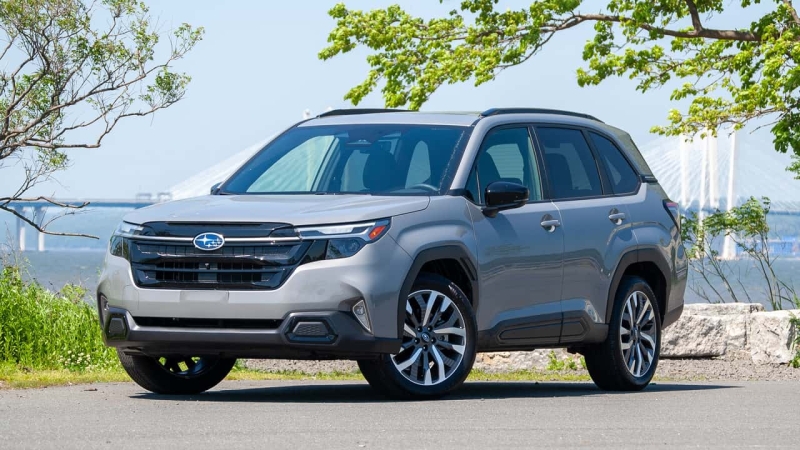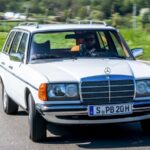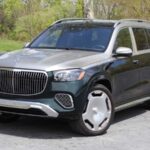Subaru’s beloved midsize crossover isn’t terribly exciting, but that probably doesn’t matter.
The Baader-Meinhof effect is experienced when someone learns about something new, then begins seeing that new thing everywhere. Hilariously, the term is named for a German terrorist group from the 1970s. According to Psychology Today, a guy named Terry Mullen learned about the Baader-Meinhof group one day, and saw its name pop up again the next day, having gone his whole life unaware of the militant ultra-left organization. He wrote about the phenomenon in a letter to his local newspaper, and the Baader-Meinhof effect was named.
Something similar happens whenever I drive a Subaru—I start seeing them everywhere. They are, of course, always everywhere. But unless you’re looking for them, they simply blend into the background.
In my tony Brooklyn neighborhood, filled with outdoorsy types who love to escape the city on weekends, Subarus blend into the scenery, filling the cracks between those old brownstones and their cast-iron fences. I’ll count at least four Subarus street-parked on any given block, and a lot of them are Foresters. Subaru seems to understand my neighbors—its customers—well.
| Quick Specs | 2025 Subaru Forester Touring |
| Engine | 2.5-Liter Flat-Four |
| Transmission | Continuously Variable |
| Output | 180 Horsepower / 178 Pound-Feet |
| Base Price / As-Tested | $31,090 / $41,390 |
For 2025, the Subaru Forester is new, though not quite all-new. The bones are the same as the before, albeit updated for added refinement and with new bodywork overtop. The engine is a carryover from the previous two generations of Forester, a 2.5-liter flat-four now making 180 horsepower and 178 pound-feet of torque. It’s paired with a continuously variable transmission and Subaru’s signature Symmetrical All-Wheel Drive. Inside, there’s a thorough reworking, though the new Forester’s cabin feels basically identical to all other Subaru models.
Subaru didn’t really need to do much with the Forester. It sold 152,566 of them in America last year, a remarkably high figure for a car about to be refreshed. People clearly love these things, so there’s no sense in messing with the formula. Just tweak what you have and let the sales roll in.
So, the 2025 Forester isn’t all that exciting. It just kind of works. Dynamically, the best thing I can say is that its soft ride eats up the worst roads you can throw at it. There are some cobbled streets in Brooklyn, and in so many cars, you have to crawl along them, so as not to send shudders through the car. In a Forester, you just barrel on through like the road surface hasn’t changed at all. You can clearly see how it’s aimed at people who spend significant time on dirt roads. As the paved roads across so much of America are deteriorating, this plush ride is no bad thing to have.
Other than that, there’s not much to note. The engine feels a bit gutless in this tktk-pound SUV, but the CVT is surprisingly refined, with not too much of the rubber-band feeling typical of these things. Still, the coming hybrid model will hopefully bring some much-needed oomph. Subaru made something of a deal of the fact that the Forester has the same steering rack as the WRX, but you’d hardly be able to tell. This car isn’t sporty in the slightest. Competent, yes, and well-refined, but not fun.
Which is fine! For the same money, you could get a Mazda CX-5, which is a lot nicer to drive. But if you’re the type inclined to buy a Forester, this Subaru is more than good enough. Still, I think there might be a better option in a Subaru showroom—the Outback. For not much more money than a Forester, you can get an Outback with a turbocharged 2.5-liter flat-four, and that extra grunt is welcome. Their form factors look different, but in reality, there are only minimal differences in size between the two.
Inside the Forester, I think Subaru is giving up quite a bit to rivals like Mazda, Honda, Kia, and Hyundai. Even in this fully loaded Touring trim, with its $41,390 base price, the Forester just doesn’t feel that nice. And while the large portrait-style touchscreen works fine, the graphics are dated and the integrated climate controls are occasionally annoying. There’s nothing dysfunctional with the Forester’s cabin, but a little bit more verve isn’t too much to ask for. And for a new model, it doesn’t feel meaningfully different inside from an Outback I drove over four years ago.
The Forester is new, but it’s the same old story for Subaru. This car sells the right image. Subaru was clever to build a brand on a perceived ruggedness, safety, and all-wheel drive back in the 1990s and it’s a strategy that’s still bearing fruit, if my neighbor’s car choices are evidence.
I sort of didn’t get the appeal. In my mind, there are better cars out there. A Mazda CX-5 is nicer in every way, and even something like a RAV4 offers Toyota’s ultra-efficient and extremely well-proven hybrid system for about the same money. But a conversation with InsideEVs Deputy Editor Mack Hogan helped put things into perspective. In a lot of ways, he’s the ideal Subaru customer—an outdoorsy urbanite—and he’s also a very perceptive car reviewer. To him, Subarus do offer that little bit more off-road ability and ruggedness than most of their rivals—a Forester is going to feel better equipped for miles of dirt road driving than, say, a Honda CR-V.
So there is substance here. Even if someone like myself who doesn’t own a paddle board or a pair of ugly hiking boots would rather spring for the superb driving dynamics and good looks of a Mazda. Still, you understand why these things seem to be everywhere. Yet a funny thing happened after I gave the Forster back to Subaru. I stopped counting them.
Competitors
- Honda CR-V
- Hyundai Tucson
- Kia Sportage
- Mazda CX-5
Get the best news, reviews, columns, and more delivered straight to your inbox, daily. Sign up For more information, read our
Privacy Policy and Terms of Use.
Gallery: 2025 Subaru Forester Touring Review
Subaru Forester
Engine 2.5-Liter Flat-Four
Output 180 Horsepower / 178 Pound-Feet
Transmission Continuously Variable
Drive Type All-Wheel Drive
Speed 0-60 MPH TBD
Maximum speed TBD
Weight 3,664 Pounds
Efficiency 26 MPG City / 33 MPG Highway / 29 MPG Combined
Seating Capacity Five
Towing 1,500 Pounds
Cargo Volume 27.5 Cubic Feet / 69.1 Cubic Feet
Base Price $41,390 (Touring)
As-Tested Price $41,390 (Touring)
On Sale Spring 2024



